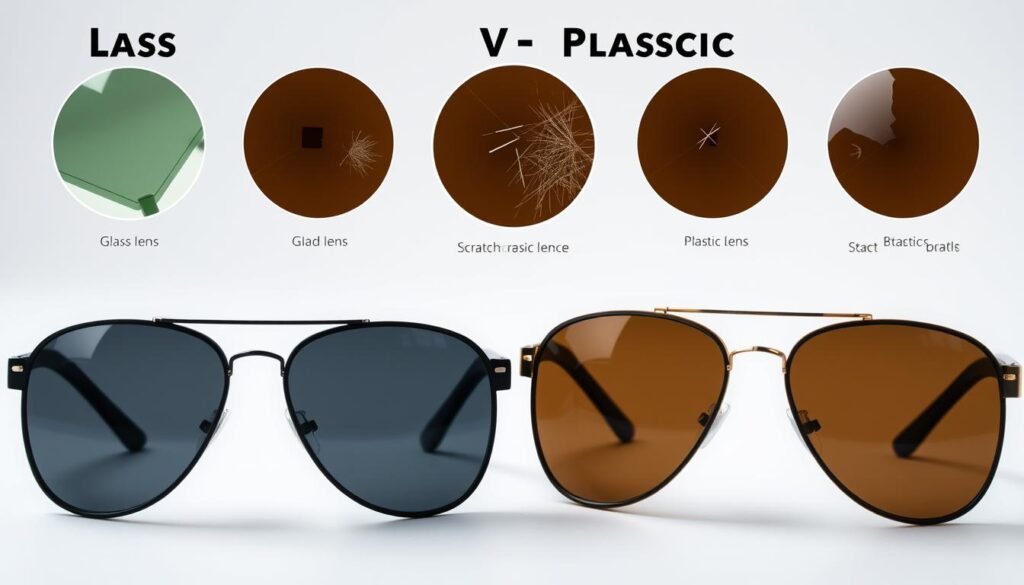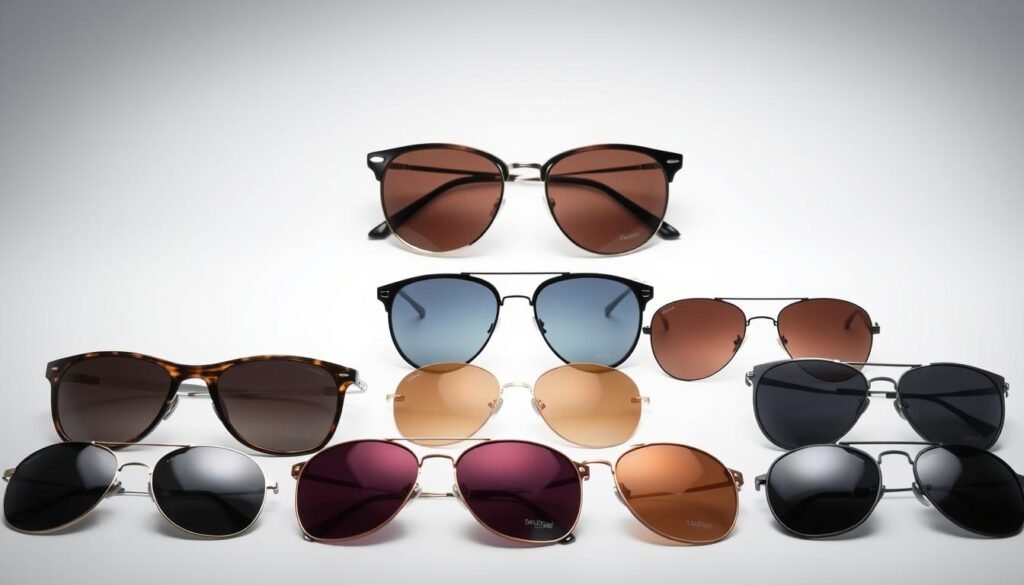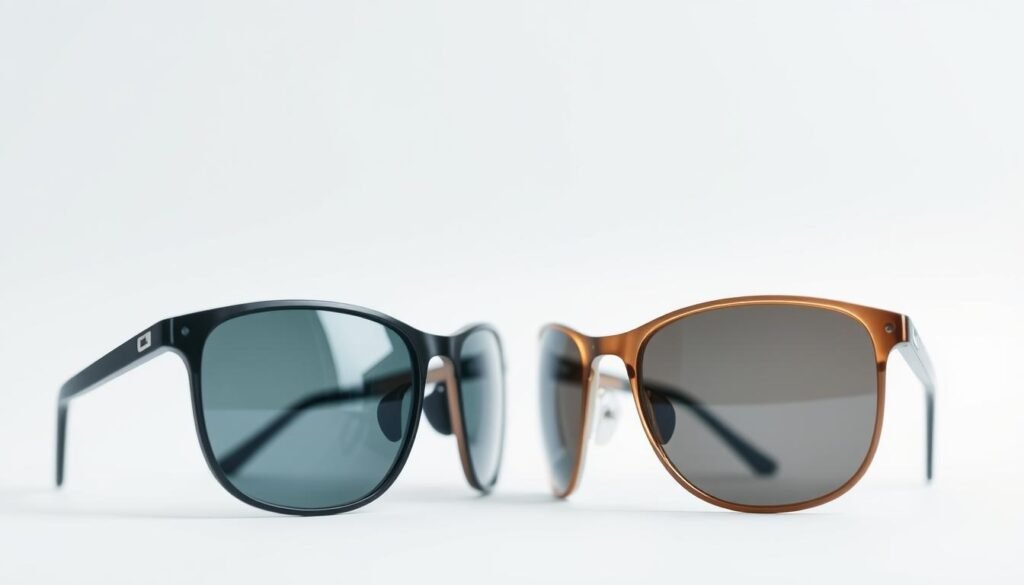Welcome to your go-to resource for selecting the ideal protective eyewear. Whether you’re upgrading your outdoor gear or buying your first pair, material choice dramatically shapes your experience. Clarity, comfort, and longevity all hinge on this critical decision.
Modern advancements have transformed both glass and polymer options. What once meant compromising on weight or scratch resistance now offers refined solutions. Today’s buyers enjoy lightweight designs without sacrificing optical precision.
We’ll explore how these materials compare across five key areas: sharpness of sight, impact resistance, wearability, sun protection, and value. You’ll discover why athletes might prioritize one type, while fashion-focused users lean toward another.
By the end, you’ll confidently choose based on your unique needs. Let’s cut through the noise and find your perfect match.
Key Takeaways
- Material choice affects visual sharpness, comfort, and product lifespan
- Glass offers superior scratch resistance but adds weight
- Modern polymers provide impact protection ideal for active lifestyles
- UV-blocking capabilities exist in both options when properly coated
- Budget and use-case determine the most practical selection
- No single solution works best for every wearer or situation
Introduction to Sunglass Lenses: Glass vs Plastic
Selecting eyewear materials goes beyond aesthetics—it shapes how you see and interact with the world. Glass and polymer options each bring distinct advantages rooted in their chemical makeup. Early 20th-century eyewear relied solely on glass, but modern synthetics now dominate 80% of the market.
Debunking Common Myths about Lens Materials
Many assume polymer equals “cheap,” but advanced plastics like polycarbonate outperform glass in impact tests. Others believe glass guarantees perfect clarity, yet high-grade resins now match its optical precision. Weight differences? Not always—thin glass designs rival some plastic weights.
Overview of Material Benefits and Limitations
Glass naturally resists scratches and provides unmatched sharpness for detail-oriented activities. Polymer alternatives shine in safety and comfort, absorbing shocks better during sports. Both achieve 100% UV protection through coatings, debunking the myth that glass alone blocks harmful rays.
Your lifestyle dictates the ideal choice. Adventurers prioritize durability, while photographers might favor distortion-free glass. Upcoming sections explore how these materials perform in real-world scenarios—from beach days to mountain trails.
Performance and Durability: Evaluating Glass and Plastic Lenses
Your eyewear’s performance hinges on material science. Let’s break down how glass and plastic options handle daily wear, extreme conditions, and time.

Optical Clarity and UV Protection
Glass naturally resists scratches, keeping vision crisp for years. Its surface stays smoother, reducing light distortion. Plastic alternatives like polycarbonate match this sharpness when polished properly.
Both materials block 100% UV rays with coatings. Brands like Revant use optical-grade polymers that meet ANSI Z80.3 standards. No squinting – just reliable protection.
Impact Resistance and Safety Standards
Polycarbonate bends where glass breaks. It withstands baseballs, trail debris, and accidental drops. Tests show plastic options survive impacts 10x better than untreated glass.
Safety-certified replacement options matter for athletes. Shatterproof designs prevent eye injuries during high-speed activities. Always check for ANSI or ISO markings.
Long-Term Durability and Maintenance
Glass wins scratch battles but loses war against drops. Plastic resists cracks but needs gentle cleaning. Store either type in microfiber cases to extend their lifespan.
| Feature | Glass | Plastic |
|---|---|---|
| Scratch Resistance | Excellent | Good (with coating) |
| Impact Survival | Low | High |
| UV Protection | Coated | Built-in |
| Weight | Heavier | Lightweight |
Extreme heat warps plastic faster. Saltwater corrodes glass coatings over time. Rotate eyewear seasonally – use glass for winter sports, plastic for summer adventures.
Lenses for Sunglasses: A Comprehensive Buying Guide
Upgrading your eyewear doesn’t require buying a whole new pair—smart shoppers know replacement options deliver premium quality at half the price. Modern services let you refresh favorite frames with advanced features, whether you need vision correction or trend-forward tints.

Tailored Solutions for Every Face Shape
Companies like Fuse Lenses let you refresh your favorite frames for under $25. Their replacements fit 4,000+ models from Oakley to Ray-Ban. “We ship prepaid boxes—just send your frames and get professional installation in three weeks,” explains their product team.
Vision Meets Fashion
Prescription wearers aren’t limited to basic options anymore. High-index plastics and thin glass materials now accommodate strong corrections without bulk. Choose amber tints for contrast enhancement or mirrored finishes that match your style.
Polarized options reduce glare better than standard coatings. Photochromic tech automatically adjusts to light conditions—perfect for drivers. Anti-reflective treatments cut screen strain by 40% in recent studies.
Seek Optics undercuts competitors at $19.99 per set while offering 60-day trials. Compare this to buying a new pair averaging $150+. Whether you prioritize color variety or impact resistance, today’s market delivers solutions matching exact needs and budgets.
Material Considerations and Frame Compatibility
Transforming your favorite eyewear starts with smart pairing. The right replacement requires matching technical specs to your existing frames. Metal, acetate, and nylon designs each demand specific lens thickness and curvature for seamless integration.
Matching Lenses to Your Frames and Orders
Thick plastic options work best with rugged nylon frames, while slim glass cuts suit delicate metal designs. Fuse Lenses’ digital template system scans your frames to ensure 0.2mm precision. “Our 3D mapping accounts for every curve,” their product team notes.
Check base curvature numbers on your old lens or frame temples. Mismatched curves cause distortion – like wearing someone else’s prescription. Most brands offer compatibility charts for popular models like Ray-Ban Wayfarers.
Installation Ease and Shipping Advantages
Revant’s SnapFit kits let you swap replacement options in 90 seconds. No tools needed – just warm water to soften frames and gentle pressure. Seek Optics includes microfiber tools to prevent scratches during DIY installs.
Free shipping kicks in at $55 for US orders at Fuse Lenses. Master technicians cut your new set within 48 hours. Worried about measurements? Brands use proprietary databases with 15,000+ frame blueprints for guaranteed fit.
Inspect existing frames for cracks before ordering. Bent hinges? Many companies offer frame repairs alongside replacement services. For vintage or complex designs, opt for professional installation – most provide prepaid return labels.
Sustainable Choices and Brand Highlights
Earth-conscious shoppers now refresh their favorite eyewear while slashing waste. Leading companies prove style and sustainability coexist through smart replacement programs that outperform buying new.
Eco-Friendly Materials and Cost Efficiency
Fuse Lenses keeps 1,000,000+ pairs from landfills by updating existing frames. Their process uses 73% less energy than manufacturing new ones. Revant’s recycled polymers cut plastic waste by 40% annually.
Savings hit hard too. A $25 replacement lens set revives $200 designer frames. Compare that to Oakley’s $180 Holbrook replacements – third-party options deliver equal clarity at 60% lower price points.
Top Brands and Quality Comparisons
Oakley Radar Path models get upgraded with shatterproof options matching original specs. Ray-Ban Aviator replacement lens kits include authentic green mirror coatings. Maui Jim’s Reefton line now offers scratch-resistant upgrades.
Warranties seal the deal. Fuse backs products for life, while Spy Optic gives 2-year coverage. Prescription wearers love swapping outdated corrections in Ray-Ban Clubmasters without changing their signature view.
“Our customers keep frames for 7+ years through smart updates,” notes Revant’s sustainability lead. With 30-day trials and free returns, testing eco-friendly choices risks nothing but saves plenty.
Conclusion
Your eyewear journey hinges on balancing priorities. Glass delivers unmatched sharpness for detail-oriented activities, while advanced polymers withstand active lifestyles. Both shield eyes effectively when properly coated.
The replacement market changes everything. Refresh favorite frames with upgraded tech at 60% less than new pair costs. Prescription updates? Done. Polarized filters? Added. This approach saves money and reduces waste.
Modern services remove hassle. Prepaid shipping, precision fittings, and lifetime warranties make swaps stress-free. Brands like Revant and Fuse deliver professional-grade results through mail-in programs or DIY kits.
Assess your needs: photographers might choose glass for distortion-free clarity, while hikers prefer lightweight shatterproof options. Budget-conscious buyers appreciate $20 upgrades that revive $200 frames.
Ready to act? Check compatibility charts, compare price points, and explore tint options. Your perfect view awaits – no full redesign required.

